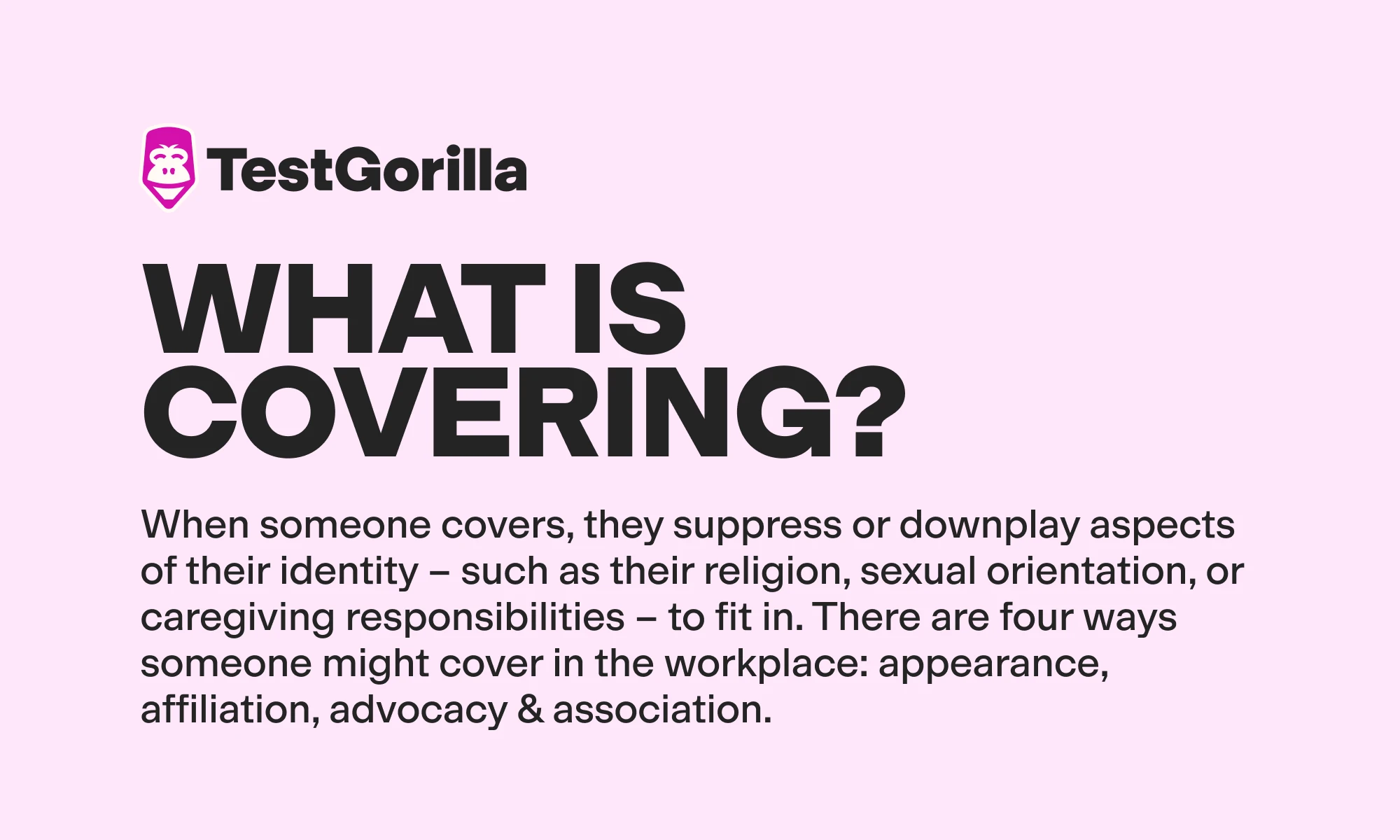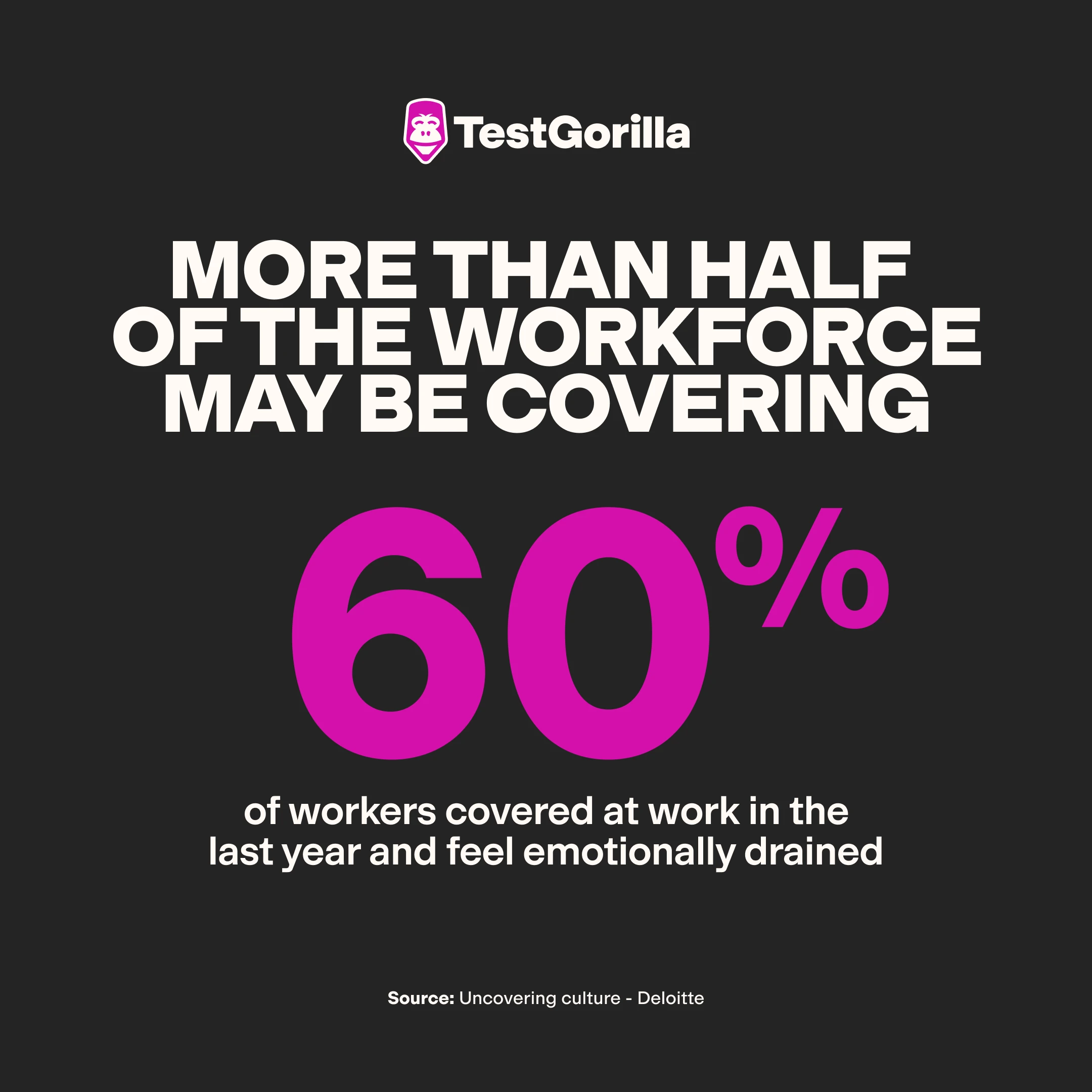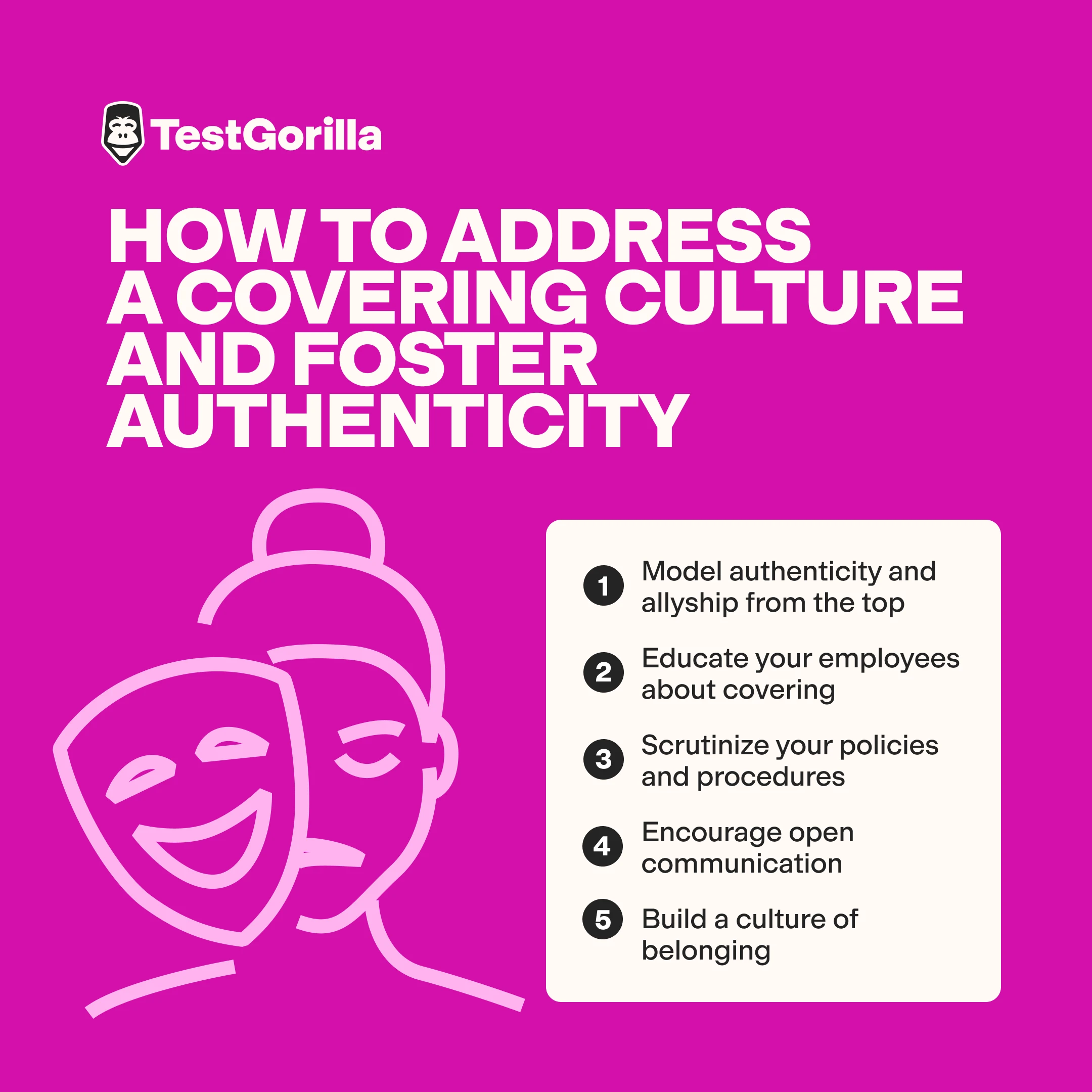Is a “covering culture” sabotaging your employees’ wellbeing?
– “I edit the way I talk and act around my coworkers so as to make myself appear ‘less gay.’”
– “As a Black woman, I don’t want to be seen hanging out with a group of only Black women. It would seem 'too Black' if we were all seen together.”
– “I don’t want people to know I was poor growing up, so I try not to talk about my childhood at work.” [1]
The above quotes collected by Deloitte reflect employees’ experience of “covering” – or downplaying their true selves – in the workplace.
Covering comes with a high cost to employees’ wellbeing and your organization’s bottom line. But, how do you know if a covering culture exists in your workplace? And, most importantly, what can you do to address it?
In this article, we look at how and why employees cover in the workplace, the impact it has on them and your business, and strategies you can use to create an inclusive and supportive work environment.
Table of contents
What is covering?
When someone covers, they suppress or downplay aspects of their identity – such as their religion, sexual orientation, or caregiving responsibilities – to fit in.
American legal professor Kenji Yoshino wrote a seminal book on the topic called “Covering: The Hidden Assault on Our Civil Rights.” He describes covering as “[toning] down a disfavored identity to fit into the mainstream.”
Employees may intentionally or subconsciously cover. Professor Yoshino identifies four ways someone might cover in the workplace:
Appearance: Altering their physical presentation. For instance, a person with tattoos on their arms might wear a long-sleeved shirt in the workplace because they’re worried about being judged. Or, a woman might remove her crucifix necklace before coming to work to avoid displaying her Christian faith.
Affiliation: Avoiding behaviors associated with a particular identity to reduce the risk of stereotyping. An example is an employee not speaking about their caregiving responsibilities in the workplace so management won’t question their priorities. Another example is a 50-year-old avoiding discussing when they graduated to avoid seeming “too old” for a role.
Advocacy: Reducing the degree to which they defend or support their group. For instance, an LBGTQ+ employee might avoid expressing their support for their community at work out of fear it could compromise future career opportunities.
Association: Minimizing contact with other members in their group. For example, a Black employee might avoid engaging with their Black coworkers at lunch, or a gay man might choose not to display a photo of his partner on his desk.
Covering is different from “masking,” where neurodivergent employees hide personality traits during interactions to better fit in. For instance, an employee with ADHD might suppress self-stimulatory behaviors like fidgeting during long meetings, or an employee with autism might force eye contact.
Covering is also different from “passing,” where someone outright hides or lies about the fact they belong to a particular group so others aren’t aware of their status. For example, a gay woman who’s recently started at a company might use male pronouns when discussing her partner in an effort to pass as straight. Or, a mixed-race employee might say they’re White.
With covering, others are aware that the individual belongs to a certain race, religion, or gender, for example – but the individual downplays their status or distances themself from their group. For instance, a woman whose colleagues know she’s gay may still avoid putting a photo of her partner on her desk or inviting her partner to work events to cover her sexuality.
All three phenomena are related and can be ultimately harmful to employees.
But in some situations, covering can be helpful or productive. For instance, employees may be expected to minimize aspects of their belief-based identities to align with and support organizational values. Kwasi Mitchell, Deloitte’s Chief Purpose and DEI Office, gave an example of this for Forbes:
Suppose your company states it believes in LGBTQIA rights and there is a person whose aspect of their identity does not accept that and has concerns with it. In that case, that's not necessarily a situation in which we'd expect someone to bring the full version of themselves to work as that would be counter to our diversity and inclusion culture overall.
Another example is an employee with culturally ingrained misogynistic views that cause him to talk over women during meetings and constantly challenges his female boss’s authority. Arguably, the employee should cover these tendencies for the sake of workplace harmony and fairness.
Like the balance between free speech and safe spaces at work, the distinction between helpful and harmful covering can be nuanced. Where does the right of one employee to be their authentic self end and the right of their coworker to feel safe and included start? We’ll get back to this.
Why do employees cover?
Covering generally happens due to a lack of workplace inclusivity, which makes employees feel like they can’t be their genuine selves. Instead, they feel the need to conform to certain expectations or pressure to assimilate. Employees worry if they don’t do this, they might be treated differently or miss out on professional opportunities.
Deloitte has extensively researched the issue of workplace covering. For a recent report by its DEI Institute in collaboration with NYU School of Law, Deloitte spoke to 1,269 US employees from businesses with at least 500 workers. It found that 60% of workers covered at work in the last year.
This means that more than half of your workforce may be covering.
Deloitte’s research identifies various reasons why employees cover. Many (63%) do it because they’re used to doing it within family or social situations. Other reasons include:
To avoid negative stereotypes or others’ judgment
For others’ convenience or comfort
For career advancement
To keep their job
What’s especially concerning? Deloitte’s findings reveal a lack of progress in addressing workplace covering. In 2013, Deloitte worked with Professor Yoshino, finding that 61% of employees were covering at work. A decade later, that number has only reduced by 1%.
The hidden costs of covering on employee wellbeing
Harmful covering significantly affects employee wellbeing. According to Deloitte’s research, 74% of employees feel negatively impacted by the pressure to cover in the workplace.
Let’s take a look at some of these negative impacts in relation to employee wellbeing.
1. Higher emotional fatigue
Deloitte’s survey found that 60% of workers who cover in the workplace feel emotionally drained. Why? Hiding certain aspects of one’s identity requires time and energy. This is mentally exhausting and unsustainable, negatively impacting employees’ job satisfaction.
Continuous emotional fatigue can also lead to serious health conditions like burnout.
Emotional fatigue and burnout come at a substantial personal cost to employees. It’s also a cost to your business when you consider lost productivity, absences, and turnover. According to another Deloitte report, “Mental health and employers: Refreshing the case for investment,” low mental health costs employers in the UK alone more than £33-£42 billion annually.
2. Reduced self-esteem
The need to cover in the workplace can profoundly affect employees’ self-esteem – how they value themselves. Constantly modifying their behaviors, appearance, or interactions to fit in can affect how they value their self-worth. They might feel less confident and more inadequate.
Self-esteem directly impacts an individual’s intrinsic motivation, workplace satisfaction, and performance – key drivers of productivity. This link is supported by Deloitte’s research, which found that 54% of workers who cover at work say it impacts their ability to perform their job to the best of their ability.
3. Diminished sense of self
Deloitte’s report also identified that 58% of employees who cover say their sense of self is negatively impacted.
An employee’s sense of self goes deeper than their self-esteem, involving their self-perception of their identity. Many employees cover because they want to belong: They downplay an aspect of their identity they perceive as “lesser” or “problematic” to conform with the broader group. In this context, their lack of sense of self and ability to be themselves not only impacts their wellbeing – it also affects their performance.
It especially affects employees’ self-expression and creativity. According to separate Deloitte research involving 28,000 professionals worldwide, 76% of employees will stay quiet if they feel they can’t be themselves. As a result, organizations are missing out on their valuable contributions.
How covering undermines DEI and wellbeing programs
With the business case for DEI (diversity, equity, and inclusion) well and truly made, it’s unsurprising that organizations are spending big on DEI initiatives. In 2023, the DEI global market was $10.9 billion, and this is projected to increase to $24.4 billion by 2030.
Employers are spending even more on employee wellbeing programs, with global annual spending in 2022 estimated to be $53.04 billion.
However, organizations that foster a culture of covering (intentionally or otherwise) undermine their investment in DEI and employee wellbeing. Instead, they’re creating non-inclusive workplaces where employees feel psychologically unsafe, stressed, and disengaged.
The legal risk of covering
A covering culture also potentially violates employees’ rights under anti-discrimination laws.
Employees are typically protected by various laws prohibiting workplace discrimination based on protected characteristics like race, religion, gender, and age. In the US, for example, these include Title VII of the Civil Rights Act, the Age Discrimination Act, and the Americans with Disabilities Act.
Covering cultures often result from discriminatory policies and practices, which put employers at risk of time-consuming, stressful, and costly lawsuits.
Some recent examples of this include:
Black police officer Chian Weekes-Rivera filed a lawsuit against the township of Maplewood and the Maplewood police Captain, alleging discrimination. Her employer, the Maplewood Police Department, flagged her for a dress code violation because she wore her hair in Bantu knots. Describing the experience to NBC News, Ms. Weekes-Rivera said, “It’s super embarrassing… It makes me feel like less than.”
The US Justice Department has started legal action against the Texas Department of Criminal Justice for suspending a clerk who asked to wear a religious head covering.
How to address a covering culture and foster authenticity
The best way to reduce covering in the workplace is to create a culture that supports authenticity, inclusivity, and psychological safety. Here are some steps you can take to achieve this.
1. Model authenticity and allyship from the top
Leadership plays a crucial role in guiding organizational culture. This is especially true when it comes to showing authenticity and allyship. According to Deloitte’s research, “leaders who uncover” (i.e., demonstrate authenticity) is one of the top ways to help reduce the pressure to cover at work.
Business leaders should encourage employees to be their authentic selves at work by modeling this approach themselves. This can be as simple as leaders mentioning aspects of their identity – such as family commitments – in casual conversation, or dressing in a way that expresses their identity. Leaders can also formally share their personal stories – for instance, at company events or employee retreats – to encourage organization-wide authenticity.
Encourage your employees to be authentic by allowing space for them to share their own stories and acknowledging and thanking them when they do. These may seem like small gestures, but they help build an inclusive culture where everyone feels comfortable to be themselves over time.
Allyship is another vital behavior for leaders to model. Being an ally involves supporting and advocating for a marginalized group you don’t belong to. It consists of recognizing and understanding the source of one’s privileges and using that awareness to uplift others.
2. Educate your employees about covering
It’s essential to educate your employees about covering from two perspectives.
Firstly, they must learn how their own actions and behaviors may pressure others to cover and what they can do to avoid this. In your DEI training, explore topics related to covering like microaggressions, unconscious bias, and psychological safety in the workplace. Encourage employees to develop a deep understanding of these concepts and reflect on how their workplace behaviors may impact others.
It’s also crucial for employees to recognize the difference between helpful and harmful covering and where their own conduct falls. At times, this can be a gray area. But generally, if an employee’s “uncovering” contributes to another employee’s covering, you might have problems.
Help your workforce develop their empathy, understanding, and active listening skills so they can better understand when their behavior might pressure others to cover.
Employees should also learn to recognize when they’re covering, as they may not realize they’re doing it. With this awareness, they can then look at why they do it – what are the sources of the pressure to cover, and how could they be addressed? They can also reflect on any negative impacts they might be experiencing as a result of covering.
While it’s not their responsibility to fix the situation, these insights can help you better understand covering in your workplace and what you can do about it.
Incorporate specific training about covering into your existing DEI training. This helps employees understand it in the broader context and gives them the tools they need to contribute to a diverse, equal, and – most importantly – inclusive workplace.
Ultimately, your employees should be encouraged to create an environment that’s free from discrimination where diverse identities can comfortably coexist.
3. Scrutinize your policies
With a deep understanding of harmful covering and how it works, you can review your existing policies and procedures to see if they support a covering culture and, if they do, how you can change them.
You must look at your policies’ direct and indirect impacts on employees.
For example:.
Does your dress/uniform policy indirectly prevent people of certain religions from wearing religious apparel, for example, by stating no head coverings are allowed?
Do you require employees to communicate formally or hierarchically? This may discourage employees with more casual communication styles from being authentic or raising their concerns in the workplace.
Do you have a mandatory overtime policy? While applying the same expectations to everyone may seem fair, it could have a disproportionate negative impact on people with disabilities or care-giving responsibilities.
Deloitte says that “organizations cannot expect workers to be authentic at work unless they create the conditions in which that authenticity is valued.” Keep this in mind when reviewing your policies – ensure they discourage harmful covering in the workplace.
In addition, look at how your policies are applied and whether this contributes to a covering culture. For example, a Dove survey of 2,000 women in the US found that Black women are 30% more likely to be made aware of a formal workplace appearance policy. Perhaps as a result, 80% of Black women are more likely to feel they have to change their hair from its natural state to fit in at work.
Finally, make sure your policies encourage helpful covering – for example, by defining the behaviors and language you won’t tolerate in the workplace.
4. Encourage open communication
By creating an environment where employees feel comfortable raising their concerns, you can address any factors contributing to a covering culture in your workplace as soon as they arise.
Encourage employees to speak openly with their supervisor or HR, reassuring them that their concerns will be addressed (and following through on this). Regularly check in with your employees and ask them to share their experiences of harmful covering at work to understand the situation better. You can also ask them to suggest possible solutions.
Identity can be a sensitive subject. Employees may be more open if they can provide this feedback anonymously. Consider anonymous employee pulse surveys to ensure employees feel safe sharing their experiences.
5. Build a culture of belonging
By fostering a culture of belonging, you support your employees to feel comfortable being themselves at work. Many of the above strategies contribute to a culture of belonging. Here are some other strategies:
Identify a clear set of organizational values to help guide employees’ behavior and decision-making.
Support workers to set up employee resource groups (ERGs) to give members the space to openly discuss issues affecting them at work, including covering.
Create diverse teams using skills-based hiring. By prioritizing skills, you signal to candidates that anyone with the right skills for the role is welcomed and valued.
Use multi-measure testing when hiring, too. This looks at various “measures,” including skills, personality, culture, and motivations. This way, you can hire workers who not only have the right skills but will also contribute positively to the team dynamics and workplace culture.
Genuine inclusion: The antidote to a covering culture
The pressure to cover aspects of their identities impacts employees’ self-esteem and sense of self while draining emotional energy. This reduces productivity and job satisfaction, increasing absences and turnover.
Companies investing in employees’ wellbeing and workplace DEI don’t want a covering culture to undermine their investment.
Support a genuinely inclusive culture by modeling authenticity and allyship from the top, educating your employees about covering, using skills-based hiring to build a culture of belonging, and closely reviewing your policies to ensure they promote open communication and inclusivity for all. This way, your employees can feel comfortable bringing their true selves to work.
[1] “Uncovering culture: A call to action for leaders.” (2023). Deloitte. https://www2.deloitte.com/content/dam/Deloitte/us/Documents/about-deloitte/dei/us-uncovering-culture-a-call-to-action-for-leaders.pdf.
Related posts
You've scrolled this far
Why not try TestGorilla for free, and see what happens when you put skills first.
Latest posts
The best insights on HR and recruitment, delivered to your inbox.
Biweekly updates. No spam. Unsubscribe any time.

Skills tests to hire the best
Our screening tests identify the best candidates and make your hiring decisions faster, easier, and bias-free.
Free resources
A step-by-step blueprint that will help you maximize the benefits of skills-based hiring from faster time-to-hire to improved employee retention.
With our onboarding email templates, you'll reduce first-day jitters, boost confidence, and create a seamless experience for your new hires.
This handbook provides actionable insights, use cases, data, and tools to help you implement skills-based hiring for optimal success
A comprehensive guide packed with detailed strategies, timelines, and best practices — to help you build a seamless onboarding plan.
This in-depth guide includes tools, metrics, and a step-by-step plan for tracking and boosting your recruitment ROI.
Get all the essentials of HR in one place! This cheat sheet covers KPIs, roles, talent acquisition, compliance, performance management, and more to boost your HR expertise.
Onboarding employees can be a challenge. This checklist provides detailed best practices broken down by days, weeks, and months after joining.
Track all the critical calculations that contribute to your recruitment process and find out how to optimize them with this cheat sheet.

















